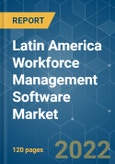The Latin American workforce management software market is estimated to record a CAGR of about 5.48% over the forecast period 2022 to 2027. The COVID-19 pandemic had an adverse effect on the workforce industry. A shortage of workforce, infrastructure, essential drugs, proper treatment, and disruption in manufacturing facilities and supply chain was experienced, reducing most sectors’ functioning. A loss of stability was witnessed in all potential end-user verticals.
The Latin American workforce management market is highly fragmented due to players like Infor, Oracle, Sierra Data Systems, ADP, Kappix, Krones Incorporated, and Atoss Software AG. They are upscaling the market with substantial R&D investments, driving toward the sustainability and digitization of the Latin American workforce management market.
This product will be delivered within 2 business days.
Key Highlights
- The Latin American workforce management market is expected to witness moderate growth due to the increasing popularity of SaaS. The persistently increasing competition to provide efficient services is encouraging organizations in the region to adopt cloud computing in workforce management to ensure faster time to transfer real-time data.
- Cloud computing is one of the fastest-growing technologies in Latin America, with the increasing deployment of SaaS and IaaS. Countries such as Brazil and Mexico are ahead in terms of cloud growth in the region because of their high numbers of connected consumers. Companies are looking for competitive advantages and ways to ensure efficient cost management and data processing.
- Regardless of the economic crisis, over the last decade, the region has witnessed a 50% increase in the number of services that middle-class consumers demand, resulting in companies scaling up their customer service operations and the adoption of cloud services.
- Cloud services have been among the essential tools for Latin American businesses. Moreover, the cloud is becoming more relevant in growing markets because it provides a unique edge to local businesses. Cloud services are cheaper and also help organizations advance technologically.
Key Market Trends
Retail and Consumer Goods to Hold the Largest Market Share
- Latin America is one of the biggest exporters to the United States and exports many products to other regions of the world. Countries like Brazil, Argentina, and Columbia have a growing labor force despite the slower population growth.
- Retail and consumer goods are expected to gain more control and visibility with a mixed and diversified workforce consisting of field service providers both externally and internally, drivers, and in-store employees. This vertical is expected to grow and evolve promptly in terms of customer needs, employment, and technological changes.
- For certain complexities, the consumer goods and retail sector needs to focus on attendance and time, employee training, labor analysis, scheduling optimization, and forecasting. These complexities can be solved with workforce management solutions by properly utilizing available resources. The power of Big Data can help these resources be achieved and provide mobile solutions for forecasting, managing tasks of employees, and budgeting.
- The software system helps track orders, inventory levels, deliveries. In various manufacturing industries, it can help generate bills of materials, work orders, and other documents related to production. Companies that possess workforce management software systems avoid outages and overstock. It is an optimizing inventory data tool, which is more accurate and advanced than spreadsheets.
Mexico to Hold the Largest Market Share
- According to Trading Economics, the GDP in Mexico was expected to reach USD 1,170 billion by the end of 2021. Mexico has a large, diversified, and strong economy with its oil sector, remittances from the United States, with exports, agriculture, mining, tourism, and industrial activities playing the most significant roles in its growth.
- The growing revenue and workforce of skilled labor from IT firms and rise in exports have spiked the demand for workforce management software. Further, according to the World Bank, Mexico’s total skilled labor force was more than 54 billion in 2021. This increases the need for an efficient workforce management system.
- With increasing support for remote work from the Mexican workforce, HR professionals are embracing AI tools in their daily operations. Companies such as peopleHum offer tools such as customizable surveys and polls to help leaders get a pulse of the workforce.
Competitive Landscape
The Latin American workforce management market is highly fragmented due to players like Infor, Oracle, Sierra Data Systems, ADP, Kappix, Krones Incorporated, and Atoss Software AG. They are upscaling the market with substantial R&D investments, driving toward the sustainability and digitization of the Latin American workforce management market.
- In April 2021, Deel, an international payroll solution, officially launched operations in Mexico, its first Latin American country. The platform offers payroll management and compliance to help companies build their team and take advantage of the global workforce.
Additional Benefits:
- The market estimate (ME) sheet in Excel format
- 3 months of analyst support
This product will be delivered within 2 business days.
Table of Contents
1 INTRODUCTION
4 MARKET INSIGHT
5 MARKET DYNAMICS
6 MARKET SEGMENTATION
7 COMPETITIVE LANDSCAPE
Companies Mentioned (Partial List)
A selection of companies mentioned in this report includes, but is not limited to:
- Active Operations Management International LLP
- NICE Systems Ltd
- Oracle Corporation
- Infor Group
- Kronos Incorporated
- Reflexis Systems Inc.
- SISQUAL
- Workday Inc.
- WorkForce Software LLC
- Blue Yonder Group Inc.
- ServiceMax Inc.
- Kirona Solutions Limited
- 7shifts
- IBM Corporation
- SAP SE
- ADP LLC
- Atoss Software AG
- Mitrefinch Ltd
- Sage Group PLC
- Roubler UK Limited Company
- Tamigo UK Ltd
Methodology

LOADING...








